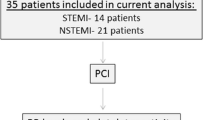Summary
Acute occlusion and subacute restenosis of the coronary artery are still the limiting factors of the otherwise successful interventional cardiology. Platelets and especially activated platelet populations play a key role concerning these typical and sometimes fatal complications. In this study we used flow-cytometry to determine the influence of the modern interventional technique of rotablation on platelet antigens and their possible alteration. A PTCA control group was included. We analyzed the fluorescence expression of structural antigens CD41a (GPII–IIIa) and CD42b (GPIb-V–IX), and of the activation-dependent antigens CD62p (P-selectin, PADGEM, GMP-140) and CD63 (GP53). Furthermore we analyzed the binding of fibrinogen to the platelet flow-cytometrically. CD41a and CD42b did not show significant alternations in fluorescence before, directly after and thirty minutes after finishing PTCA and rotablation (PTCA: CD41a p=0.8 and 0.9; CD42b p=0.5 and 0.2; rotablation: CD41a p=0.2 and 0.2; CD42b p=0.4 and 0.1). But platelet activation could be detected directly after PTCA and rotablation measuring the mean channel fluorescence intensity (MCFI) of CD62p, CD63 and fibrinogen binding (all p<0.05). Thirty minutes after finishing the procedures there were again significant changes in MCFI in PTCA (CD62p, CD63, fibrinogen binding; all p<0.05), but not in rotablation (CD62p p=0.1; CD63 p=0.9; fibrinogen binding p=0.5). But MCFI for CD62p and fibrinogen binding in rotablation was higher than in PTCA. The results of our study show that rotablation also induces significant platelet activation that is higher than in PTCA alone. Flow cytometry is a sensitive and specific, multiparametric tool in establishing platelet activation. The individual platelet activation process is part of a complex cascade of events happening in the rotablated coronary segment leading to a vascular-molecular inflammatory process and consecutive clinical problems in some patients.
Zusammenfassung
Zu den bis heute erfolgslimitierenden Faktoren der interventionellen kardiologischen Verfahren zählen die akute und subakute Okklusion und die Restenose. Bei den genannten Komplikationen sind aktivierte Thrombozyten maßgeblich beteiligt. In dieser Studie wurde mittels der Durchflußzytometrie der Einfluß der Rotablation auf die Expression von Thrombozytenantigenen analysiert. Als Kontrollgruppe wurde ein Patientenkollektiv mit alleiniger PTCA untersucht. Es wurden die Fluoreszenzexpressionen der Strukturantigene CD41a (GPIIb–IIIa) und CD42b (GPIb-V–IX), der aktivierungsabgängigen Epitope CD62p (P-Selektin, PADGEM, GMP-140) und CD63 (GP53) und die Bindung von Fibrinogen vorher, direkt nach der Prozedur und dreißig Minuten nach Ende der Prozeduren gemessen. CD41a und CD42b zeigten keine signifikanten Veränderungen im Verlauf von PTCA oder Rotablation (PTCA: CD41a p=0,8 und 0,9; CD42b p=0,5 und 0,2; Rotablation: CP41a p=0,2 und 0,2; CD42b p=0,4 und 0,1). Direkt im Anschluß an die PTCA bzw. Rotablation ließen sich signifikante Anstiege der MCFI-Werte (mean channel fluorescence intensity) von CD62p, CD63 und der Bindung von Fibrinogen nachweisen (p<0,05). Dreißig Minuten nach Ende der Verfahren zeigten sich signifikante Anstiege der MCFI bei der PTCA (CD62p, CD63 und Fibrinogenbindung, alle p<0,05), nicht aber bei der Rotablation (CD62p p=0,1; CD63 p=0,9; Bindung von Fibrinogen p=0,5). Die MCFI-.Werte für CD62p und die Bindung von Fibrinogen waren bei der Rotablation höher als bei der PTCA. Unsere Ergebnisse zeigen, daß es bei der Rotablation zur signifikanten Thrombozytenaktivierung kommt, die stärker ausgeprägt ist als bei alleiniger PTCA. Zum Nachweis der Aktivierung ist die Durchflußzytometrie als sensitives, spezifisches, multiparametrisches Meßverfahren geeignet. Die Aktivierung von Thrombozyten ist Teil einer komplexen Kaskade, die nach einer Intervention im behandelten Koronargefäß abläuft und zu einer überschießenden vaskulär-molekulären Entzündungsreaktion und klinischen Problemen bei einigen Patienten führen kann.
Similar content being viewed by others
Author information
Authors and Affiliations
Additional information
Eingegangen: 21. April 1999, Akzeptiert: 14. Juli 1999
Rights and permissions
About this article
Cite this article
Bau, J., Gutensohn, K., Kuck, K.H. et al. Durchflußzytometrisch nachgewiesene Aktivierung von Thrombozyten im Verlauf der Rotablation. Z Kardiol 89, 15–20 (2000). https://doi.org/10.1007/s003920050003
Issue Date:
DOI: https://doi.org/10.1007/s003920050003




